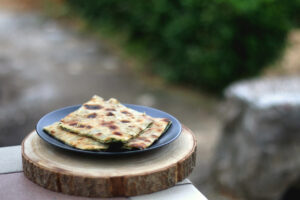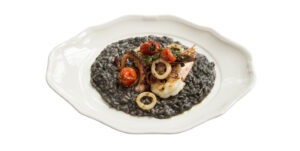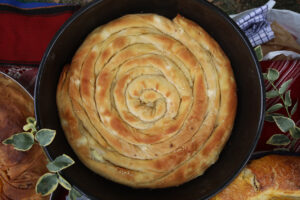
Croatia is a mix of cultures and cuisines. Formerly a republic within Yugoslavia, it became an independent country in 1991, and joined the European Union in 2013.
Like most countries, Croatian cuisine varies from region to region – from Dubrovnik and Split on the Dalmatian Coast with a Mediterranean-like cuisine to a more Central European cuisine inland, near the capital city of Zagreb to the northern region of Istria where the cuisine is influenced by Italian traditions.
Oldways will be visiting beautiful Croatia in October 2024 for a culinary journey along the Dalmatian Coast — Dubrovnik to Split. As we daydream about our upcoming trip, here are 5 iconic dishes from Croatia.
Peka – Cooking Under the Dome
 Cooked in an open fireplace in a dish with a metal lid, Peka (which literally means cooking under the lid) is typically made with meat or seafood and is very traditional in Croatia. As described by Miroslav Nikolic in the book, Croatian Cookbook, “Peka is considered a versatile dish as it can include either seafood or meat. Due to its proximity to the sea, the seafood version is mainly served on Dalmatian islands. It starts with the octopus or other types of seafood in round and thick baking pan that is mixed with potatoes and other vegetables by choice. The pan is then covered with a bell-shaped metal lid and is placed on burning wood. All sides of the pan, including its lid, must be covered with charcoal and embers to make sure all sides of the dish are cooked to perfection. The process takes hours as the dish requires slow cooking.” In October at the Oldways Culinaria, we’ll get to see and taste peka at a traditional family-run restaurant, Koraceva Kuca (along with a great meal, music and dancing).
Cooked in an open fireplace in a dish with a metal lid, Peka (which literally means cooking under the lid) is typically made with meat or seafood and is very traditional in Croatia. As described by Miroslav Nikolic in the book, Croatian Cookbook, “Peka is considered a versatile dish as it can include either seafood or meat. Due to its proximity to the sea, the seafood version is mainly served on Dalmatian islands. It starts with the octopus or other types of seafood in round and thick baking pan that is mixed with potatoes and other vegetables by choice. The pan is then covered with a bell-shaped metal lid and is placed on burning wood. All sides of the pan, including its lid, must be covered with charcoal and embers to make sure all sides of the dish are cooked to perfection. The process takes hours as the dish requires slow cooking.” In October at the Oldways Culinaria, we’ll get to see and taste peka at a traditional family-run restaurant, Koraceva Kuca (along with a great meal, music and dancing).
Soparnik
 Soparnik is a savory pie usually made with Swiss Chard, onion, garlic and parsley. It’s traditional in Dalmatia, near Omis, and has a geographic origin protection from the European Union. As a savory pie, its origin could be related to Italian pizzas and also to swiss chard pies in Greece or Gozleme in Turkey.
Soparnik is a savory pie usually made with Swiss Chard, onion, garlic and parsley. It’s traditional in Dalmatia, near Omis, and has a geographic origin protection from the European Union. As a savory pie, its origin could be related to Italian pizzas and also to swiss chard pies in Greece or Gozleme in Turkey.
If you join us in the fall in Croatia, you will meet Nikolina in the village of Gata, who will demonstrate how to make Soparnik, cooked in a wood fire, at her home high above the town of Omis. It is a special experience that you can preview through this video.
Brodet
“Brodet is Croatia’s version of Italian brodetto and is made with at least three different kinds of thick, meaty fish, such as scorpion, rockfish, and perch. Shellfish (e.g., scampi, mussels, crabs) and conger eel can also find their way into brodet. Brodet is often served with polenta, which acts as a sponge to soak up the flavorful broth” find more here.
Risotto
 When Sara was in Croatia in February for a planning trip, she found risotto on almost every menu. In Dalmatia, as a coastal region, seafood risotto is particularly popular. This dish highlights Croatia’s similarities to the Mediterranean Diet.
When Sara was in Croatia in February for a planning trip, she found risotto on almost every menu. In Dalmatia, as a coastal region, seafood risotto is particularly popular. This dish highlights Croatia’s similarities to the Mediterranean Diet.
Black Risotto is also characteristic of the Croatian coastal regions. As in other black rice dishes in other countries (Arroz Negro in Spain or Risotto Nero in Venice), the black color comes from squid or cuttlefish ink.
Burek
 Burek, börek, or bourekas, or byure, depending on country of origin, are phyllo pastries stuffed with anything from meat to greens to cheese to mashed chickpeas or potatoes. As described in Liliana Pavic and Gordana Pirker-Mosher in their book, The Best of Croatian Cooking, “burek or variations of it, are found through the Balkans Greece, Turkey and the Middle East.
Burek, börek, or bourekas, or byure, depending on country of origin, are phyllo pastries stuffed with anything from meat to greens to cheese to mashed chickpeas or potatoes. As described in Liliana Pavic and Gordana Pirker-Mosher in their book, The Best of Croatian Cooking, “burek or variations of it, are found through the Balkans Greece, Turkey and the Middle East.
If you find these dishes exciting and interesting, think about joining us from October 27 to November 3, 2024, in Croatia. Think fast, too, as we get close to a sold out Culinaria!
Dobar tek! Or, Bon appetit in Croatian, but don’t worry about learning Croatian, everyone speaks English in Croatia (English classes are required, starting in 1st grade!)





